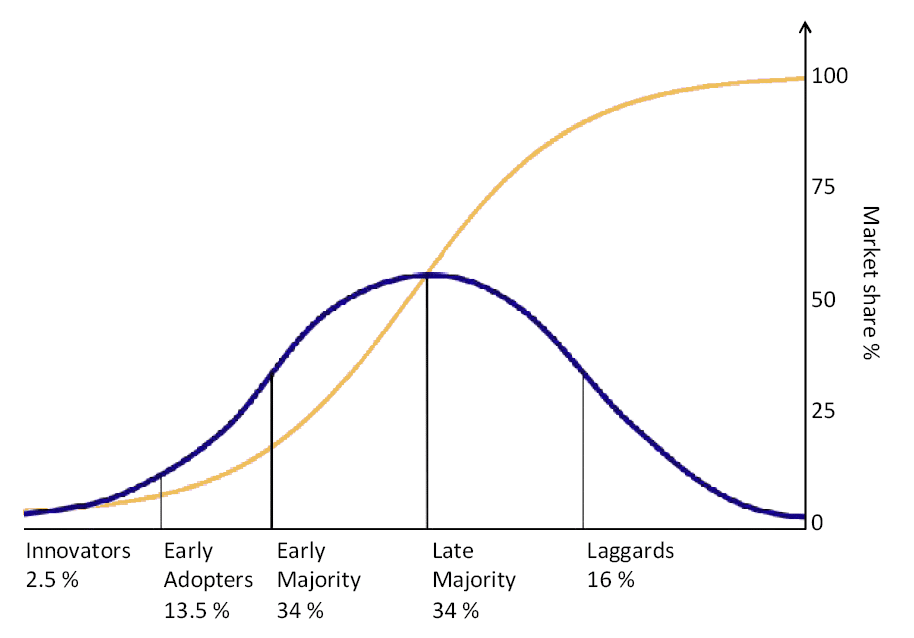Myths vs. Reality of D365 Business Central – Why NAV and GP Users Are Steadily Migrating
Since hitting the market in 2016, Dynamics 365 Business Central has steadily gained popularity among small to mid-sized businesses. With any new technology, there is typically an adoption lifecycle. This model is illustrated as a bell curve, with a smaller number of innovators, then a larger number of early adopters, and peaking with the early majority. At that point, most have already implemented the technology and the bell curve begins to decline with the late majority and laggards. This theory is the Diffusion of Innovations developed by Everett Rogers in 1962. This theory holds true today and fits the typical adoption timeline for ERP software.
When we look at the adoption bell curve for Dynamics 365 Business Central, we feel we’re in the beginning to mid-stage of the early majority. Over the last 12 months, we’ve seen an exponential increase in new Business Central users. Aside from the high product quality and business benefits of implementing Business Central, the fast uptick in users is like due to the current business environment. The COVID pandemic forced businesses to change their processes and find a new way to serve clients remotely. Having a cloud-based ERP solution accelerated the ability to work remotely and continue to deliver customer service, products, and services from any location.
Why NAV and GP Users are Migrating to D365 Business Central
Many businesses that are an ideal fit for Business Central currently have an on-premise ERP solution such as Dynamics GP or Dynamics NAV. Users of these legacy systems can be hesitant to replace their current solutions with newer technology. There are many myths around Business Central that we’ll address to help clarify why so many small to mid-sized businesses are steadily moving to Dynamics 365.
Business Central Myth vs. Reality 1: Business Central doesn’t have the functionality needed to run my business compared to NAV or GP
Reality:
Dynamics 365 Business Central is based on the Dynamics NAV platform and includes the full features and functionality from that legacy solution but built into the cloud.
Microsoft is heavily invested in Dynamics 365 and a large team of developers are constantly updating the product to expand functionality beyond the legacy product to meet the needs of today’s businesses.
Business Central Myth vs. Reality 2: There is not a way to process payroll in Business Central.
Reality:
Business Central does not currently include a payroll solution out of the box, but ISV solutions are available that integrate directly into D365 to give you payroll functionality.
Thousands of ISV add-on solutions are available from the Microsoft AppStore that can integrate directly with the solution to meet specific business or industry needs and requirements.
Business Central Myth vs. Reality 3: The cloud isn’t secure
Reality:
Moving your systems to the cloud means you have the full force of Microsoft heading up your infrastructure, security monitoring, threat management, intrusion detection, and stability. With an up-time of 99.9% and redundancy built-in, your data is always accessible and secure. Additionally, the Microsoft cloud is in compliance with 90 different regulations, including 35 compliance offerings specific to the needs of industries such as health, government, finance, education, manufacturing, and media.
Business Central Myth vs. Reality 4: Business Central is more expensive than NAV
Reality:
When comparing the cost of on-premise software to Dynamics 365 in the cloud, the real savings come into play when you consider infrastructure and IT resources. When your software lives on your server, you’re responsible for the costs associated with the hardware, backups, maintenance, patches, and security. By transitioning your software to the cloud, all of those responsibilities and costs are shifted to Microsoft. Additionally, you will no longer have to pay for your IT team, or software partner, to complete upgrades.
With Dynamics 365 Business Central, you pay for exactly what you need at any given time and you have the ability to scale up or down your user count without any penalty.
How Businesses Benefit from Transitioning to Business Central
Businesses that have transitioned to Business Central are better able to deal with the changing economy and business environment and scale their solution up and down as needed. Digitally transforming your business with technology is proven to generate a fast ROI through gained efficiencies, reduction in manual labor, and insights into data to make strategic business decisions.
As more companies move to Business Central, we’re getting further along the adoption curve. When we start to enter the latter part of the bell curve, the late adopters and laggards will still benefit from implementing Business Central, but will already be falling being competition. Companies up and running on Dynamics 365 can immediately start reaping the benefits are able to make strategic decisions that allow them to save on labor hours and increase customer satisfaction and sales.
The business environment is more competitive than ever before. Now is the time that you should be putting Business Central in place at your organization.
Reach out to the experts at Stoneridge Software to find out how your business will benefit from Dynamics 365 Business Central.
Under the terms of this license, you are authorized to share and redistribute the content across various mediums, subject to adherence to the specified conditions: you must provide proper attribution to Stoneridge as the original creator in a manner that does not imply their endorsement of your use, the material is to be utilized solely for non-commercial purposes, and alterations, modifications, or derivative works based on the original material are strictly prohibited.
Responsibility rests with the licensee to ensure that their use of the material does not violate any other rights.





